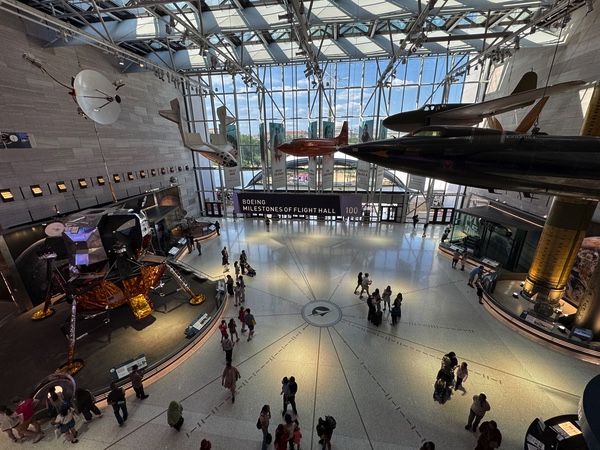Commercial space at the National Air and Space Museumby Jeff Foust
|
| It includes both familiar objects in new settings and new space artifacts, reflecting the greater role of the private sector in spaceflight. |
Whether and how Discovery might be moved to Houston is uncertain. The Smithsonian has argued that Discovery no longer belongs to NASA: ownership of the orbiter, it says, was formally transferred to the Smithsonian when Discovery arrived at the museum in 2012. Getting the orbiter from Northern Virginia to Houston is also a problem, with the aircraft previously used to transport the shuttles long since decommissioned (one, ironically, is on display at Space Center Houston, with a replica shuttle mounted on it.) The bill sets aside at least $5 million of the $85 million for transporting Discovery, but a recent Congressional Research Service report found estimates for transportation ranging from $8 million to $55 million, with the cost of a new facility for hosting the orbiter reaching $325 million.
That debate overshadows more positive developments at the museum’s flagship location on the National Mall. Last week, the museum opened a section that just completed renovations, joining a section opened in the fall of 2022 (see “Screens and spaceships: inside the renovated National Air and Space Museum,” The Space Review, October 24, 2022). It includes both familiar objects in new settings and new space artifacts, reflecting the greater role of the private sector in spaceflight.
With the renovations still in progress, the museum has closed its entrance on Independence Avenue and opened the one on the other side of the building, facing the Mall. (It still requires visitors to obtain free timed entry tickets in advance; on a Thursday afternoon all the hourly time slots for the upcoming Sunday were available, as were nearly all for Saturday.) This means that visitors now enter directly into the museum’s centerpiece, the Milestones of Flight Hall.
People who visited the hall before the renovations will find it both familiar and refreshed. Yes, there’s the Apollo LEM standing in one corner, with John Glenn’s Mercury capsule, Friendship 7, along with Gemini 4 nearby. Overhead are the X-1, X-15, and SpaceShipOne, just like before.
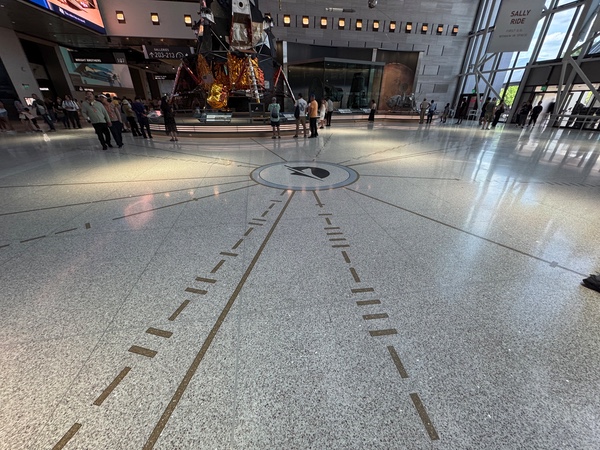 A ground-level view of the Milestones of Flight Hall with the museum logo and a pattern of lines—an homage to the Pioneer plaques—extending from it. (credit: J. Foust) |
The biggest change one immediately notices is that hall seems much more spacious. The artifacts that once crowded the hall have been moved to the sides, or out of the hall entirely, creating a large open space. The Apollo 11 command module, once at the center of the hall, was moved upstairs to the Destination Moon gallery in the first phase of renovations, and remains there today. The museum’s logo takes its place in the floor of the hall, with a series of dashed lines emanating from it: an homage to the pulsar map etched on the Pioneer 10 and 11 plaques. It’s an interesting touch, best appreciated when viewing the hall from the second floor, but may be too subtle for many visitors to notice.
Thematically, it may make sense to include the Apollo 11 module in the Destination Moon exhibit; the museum also moved Lindbergh’s The Spirit of St. Louis airplane, which once hung from the ceiling of the Milestones of Flight Hall, to the Barron Hilton Pioneers of Flight Hall nearby. But the Destination Moon hall is crowded and a bit dark, and the capsule often loses the battle for visitors’ attention to adjacent screens showing a history of the ’60s. Might it gain more attention back in the Milestones of Flight Hall, as one of the museum’s most prominent milestones of flight?
 The “Why Go to Space” exhibit includes items ranging from toys and posters to t-shirts and a SpaceX Crew Dragon pressure suit worn by private astronaut Sian Proctor. (credit: J. Foust) |
The other new gallery of interest for space enthusiasts is “Futures in Space”. The museum describes it as taking on several questions: “Who decides who goes to space? Why do we go? And what will we do when we get there?” It includes an eclectic collection of artifacts, from flight hardware to cultural items, to address those questions.
One wall in the gallery includes a grab bag of such items under a sign “Why Go To Space?” stating that they represented “the most common motivations.” They range from toys and model rockets to a poster for the Chinese sci-fi movie The Wandering Earth and an Atari 2600 “Asteroids” video game cartridge. There was also a SpaceX “Occupy Mars” t-shirt alongside a ‘TFNG We Delivered” t-shirt owned by Sally Ride, a reference to her 1978 astronaut class.
Another part of the exhibit is devoted to concepts for Mars missions and settlements, including a portion in the corner intended to look like a 3D-printed Mars habitat. Inside, a brief film is projected on screens on three sides about the experiences of Mars analog astronauts discussing the psychological challenges astronauts on future long-duration Mars missions will face.
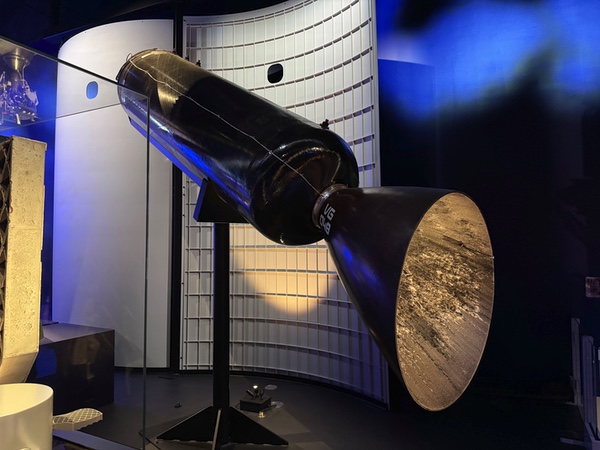 The hybrid rocket motor used by Virgin Galactic’s SpaceShipTwo on its first suborbital spaceflight in 2018 is on display. (credit: J. Foust) |
Perhaps the most noteworthy aspect of the exhibit, though, is the collection of commercial space artifacts. For much of the early history of the museum nearly all the space artifacts came from NASA or other government space programs, a reflection of the lack of commercial activity. That has gradually changed, with SpaceShipOne installed 20 years ago and the “One World Connected” exhibit, next to Destination Moon, including several commercial spacecraft, like a Dove cubesat from Planet and a flight spare of a Sirius Satellite Radio spacecraft built by Space Systems Loral.
Futures in Space, though, features a mix of models and flight hardware from several companies. Astrobotic provided a full-scale model of its Peregrine lunar lander, which malfunctioned on its way to the Moon last year, while Blue Origin gave a full-scale model of the crew capsule of its New Shepard suborbital vehicle. Flight hardware includes a Falcon 9 grid fin, the hybrid rocket motor Virgin Galactic’s SpaceShipTwo used on its first suborbital spaceflight in 2018, and the pressure suit worn by private astronaut Sian Proctor on the Inspiration4 mission in 2021.
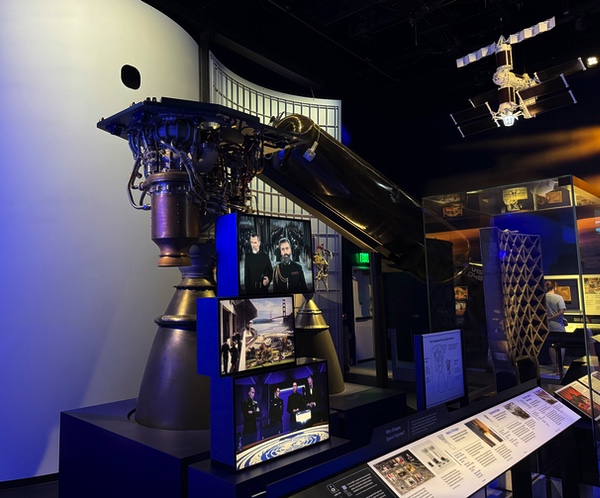 A portion of the gallery that includes rocket engines, a Falcon 9 grid fin, a commercial space station model, and… stills from science-fiction shows. (credit: J. Foust) |
In another display case, a pressure suit worn by Yuri Gagarin during training for his historic 1961 orbital flight is placed next to the blue flight suit worn by Katya Echazarreta, who went on a New Shepard suborbital flight in 2022. Between them is a set of commercial astronaut wings awarded by the FAA to Virgin Galactic’s Beth Moses.
Anecdotal evidence from a visit to the gallery suggests people were fascinated with those commercial items: one person stared at the Falcon 9 grid fin, hand over mouth, perhaps contemplating the scale of the rocket that fin is from. But people were also excited by the replica of R2-D2 in the gallery, next to the Peregrine lander. That mix of sci and sci-fi was a little confusing at times: it was not clear why there were images from Dune, Star Trek, and The Expanse illustrating different forms of governance from science fiction next to models of rocket engines from Rocket Lab and SpaceX.
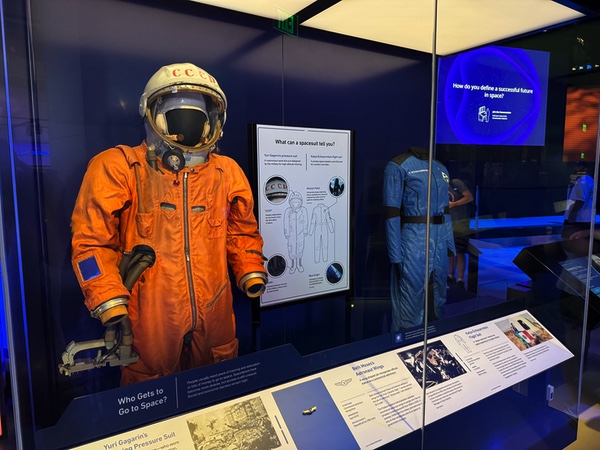 A pressure suit worn by Yuri Gagarin in training, next to a flight suit worn by commercial astronaut Katya Echazarreta. Between the two are FAA commercial spaceflight wings awarded to Virgin Galactic’s Beth Moses. (credit: J. Foust) |
The gallery is, perhaps, a work in progress, like the rest of the museum: the eastern end is still closed off for renovations. When it opens next year, for the museum’s 50th anniversary, it will include new galleries on “Discovering the Universe” and “Living in Space” among others. The Skylab flight spare on display there is clearly visible behind the barricades, waiting for visitors to return.
And if efforts to transfer Discovery to Texas succeed, commercial space might come to the rescue of the Udvar-Hazy Center: one can imagine putting spacecraft, rocket stages, and more in the hangar that hosts the shuttle, representing the growth of commercial space capabilities. Even that might have some limits, though: getting a Starship to the museum might be as difficult as transporting a shuttle from it.
Note: we are now moderating comments. There will be a delay in posting comments and no guarantee that all submitted comments will be posted.
